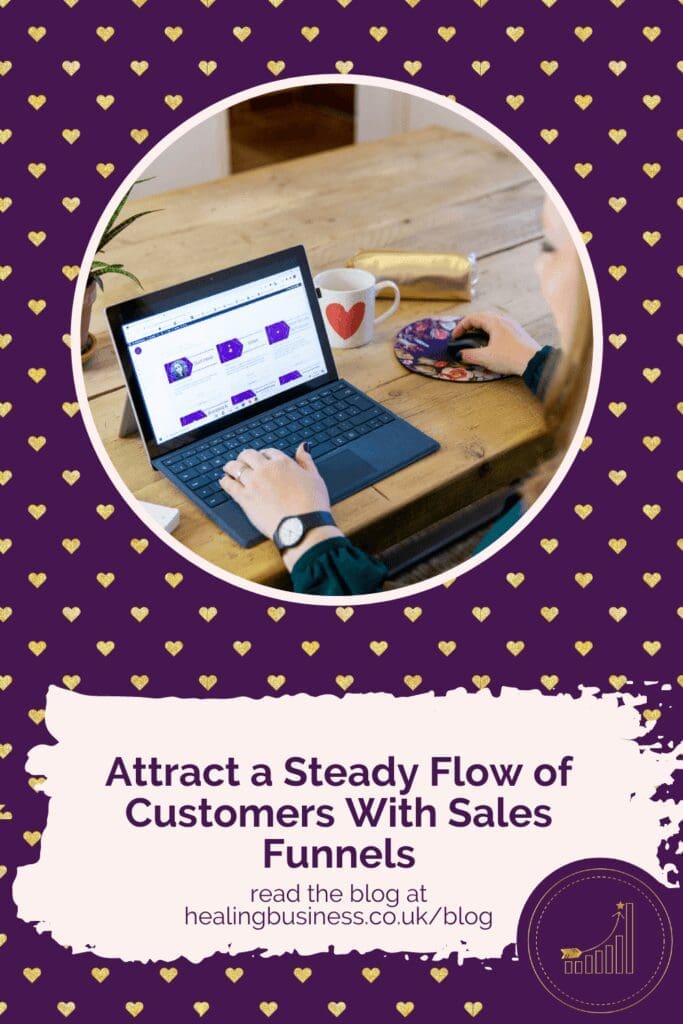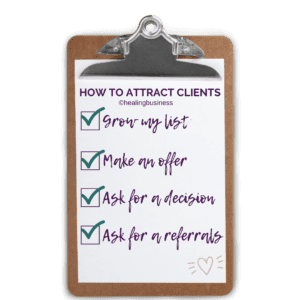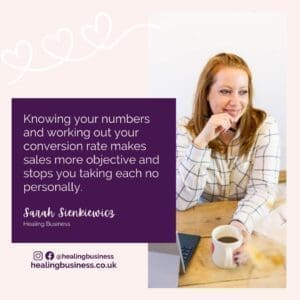Attract a Steady Flow of Customers With Sales Funnels
I’m one of those people whose brain works like a spreadsheet! I have a system for everything – at home and at work! To me, there’s something so beautiful in a process that works efficiently. It’s like a dance with serenity, with all the pieces connected and interacting in perfect harmony! It brings me peace and comfort. I’m not sure I’ve ever said that out loud before!
You may be one of those people who can think of systems as boring, but they can bring a grounded energy to your business and free up your time to do more of what you love.
And what’s so refreshing is when you know your numbers, you can be objective about the results you’re getting (or not) in your business and take it way less personally!

I like to think of your business as having an energetic entity of its own. This entity has a form and personality. You can tune in with it, connect and gain answers to your questions. And just like any energy body, the energy flow can get blocked sometimes. I see systems, work flows and numbers as a way to tune in to your business, unblock what’s stuck and get the stagnant energy flowing again. Here’s how you can use that healing process with your marketing and sales funnels to attract clients. When you understand your numbers at each stage of the funnel, you can then calculate your conversion rates and boost your sales.
There are 4 key elements to your sales funnel.
Having each element in place will help you to understand your numbers at each stage and from there you can work out your conversion rates. Have a look through the list and see what you already have in place and what areas you need to work on to get results flowing.

1. Grow Your List / Audience
When you know your vision, mission, purpose and ideal client (see my previous blog post on how to develop your ideal client profile), the next step is to connect with the right people and start to build relationships.
You can do this via networking, building a platform on social media, displaying and distributing leaflets locally and attending and exhibiting at events. It is strongly advised that you build an email list as you go as this will become one of the most valuable assets in your business.
Remember to cultivate the relationships and keep in touch with people regularly. This isn’t just about gathering a list of names or email addresses. This is about making meaningful connections with people.
How many people are on your email list?
How many people signed up to your webinar/challenge?
2. Make An Offer
When people are ready to take the next step and find out more about what you offer it’s good to be ready!
Do – share with confidence and enthusiasm. You can share your offer a number of ways – via a sales page on your website, video presentation, webinar, 1-1 discovery call or an invitation to an event.
Don’t – be a Spammy Pammy! It’s good to know if that person is open or ready for what you have to offer because otherwise you could come across as spammy. There’s nothing worse than being sold something you have no interest in buying. It’s a waste of everyone’s time and can turn people off. What kinds of questions can you ask to be sure that your product or service is going to solve that person’s problem? This is called “pre-qualifying” and will help you to increase the amount of people saying yes to your offer.
How clearly are you communicating your offers?
How regularly are you promoting your offers?
How many people visited your sales page?
3. Ask For A Decision
Don’t be scared to ask for the business! Make it clear what the next steps are for your prospective customer to take and simply ask them if they would like to move forward. Running a free webinar or challenge and then not giving people the opportunity to work with you to get even deeper results, does you both a disservice.
If you’ve asked for the sale and the answer is yes – great! Be clear about next steps and make it easy for them to pay and receive the product and service. Give excellent customer care!
If the answer is no – be confident to ask the reasons why. Find out what the objections are and see if they can be resolved. It’s worth thinking in advance about the reasons why people may not want to move forward and think about how you can resolve their concerns. It may simply be a timing thing, if so, schedule a time to follow up and keep in touch. How can you build this follow-up process into your diary? You can also build in the objections to your content going forward to answer those questions your prospective clients have.
How confident are you when asking for a decision?
How many people say yes to your offers?
Do you have a tried and tested process to follow up?
4. Ask For Referrals
Testimonials and recommendations are a great way to build credibility and connect you with people you might not have met without that introduction. Think about how you will reward your loyal customers who recommend you to others. Saying thank you is not just polite, but it may give them an incentive to find new customers and do your marketing for you!
Share success stories (with your clients’ permission and of course respecting confidentiality). Storytelling helps to bring the benefits of your product or service to life and is a great way to get your message across when you are endorsed by others.
How many people come to you via referrals?
How can you encourage, incentivise and reward people who make referrals?
To find out about the Healing Business Affiliate Program and get paid to recommend our products and services (subject to successful application and signed agreement) watch this short video series.
Using Your Conversion Rates To Set Sales Targets and Analyse Launch Data
Knowing your numbers can help you create a steady flow of clients into your business with three key questions
1. How many customers would you like?
2. On average, how many of your customers that see your offer say yes?
3. Therefore, how many people do you need to see your offer?
Let’s keep the numbers simple and look at an example.
- You would like 10 customers.
- Typically 1 in 3 say yes.
- You will need to show your offer to 30 people to attract 10 customers.
Work out your numbers based on your marketing metrics and that will give you the key to knowing what activity and action steps you need to take going forward.
It’s important to be aware that different marketing activities will bring different results – for example, 1-1 discovery calls will give a different ratio to group webinars, and different business owners will have different skill sets, so it’s ideal to look at your own conversion stats from your recent business activity and calculate your own figures.
The industry average conversion rate is 0.02% and it’s advised to not change too much about your offer until 100 people have seen it because then you can know what part of your customer journey needs tweaking. Making changes without enough data can give you a skewed perspective of what part needs to be tweaked. For example, if only 10 people come to your challenge 10 x 0.02 = less than 1 person. You might have the best offer, just not enough eyes on it to make the numbers work in your favour.
Goal Setting before a launch:
Formula: number of clients would like / conversion rate = goal number of people to make offer to
example 1
Say you would like 5 clients and are hosting a webinar. Taking the industry average conversion rate of 2%.
5/0.02 = 250
Therefore you would need to aim for 250 in your webinar / challenge.
example 2
Remember that your conversion rate may be higher or lower than industry average. If you have a lot of loyal customers in your audience who already know, like and trust you then it will likely be higher. If you are just starting to build relationships and authority, then it could be lower.
Let’s look at the numbers in the scenario if you have a lot of loyal customers or a no brainer offer, and your conversion rate is 10%
5/0.10 = 50
Therefore you would need 50 people on your webinar/challenge.
When thinking of your audience/list size consider the quality as well as the quantity.
Analysing data during or after a launch: Calculating your conversion rates
example
Say you had 250 people land on your opt in page and 125 people sign up for the webinar/challenge
125/250 = 60% opt in conversion rate
Of those 125 people, 50 people showed up
50/125 = 40% engagement
Of those 50 people, 5 bought
5/50 = 10% purchase.
Overall, your conversion rate of total people 5/250 = 2% conversion rate, the industry average!
It’s useful to break it down for each step so you can improve the rates of opt ins, engagement and sales throughout the whole customer journey.
Using This Data To Know Where To Focus and Attract More Clients
If you are experiencing feast or famine cycles in your business you can easily look through each step of the process and see what action to take to get things flowing steadily.
No list >> how can you meet more people and grow your list / audience?
Big list, no sales >> what can you improve about your offer, your sales page?
Lots of objections/no >> What feedback or common objection are you getting? How can you use this knowledge to make improvements to your pitch and reassure people of their concerns? Does this highlight a limiting belief of yours?
No testimonials, referrals >> Are you being vocal in asking for them? How can you make it a part of your customer journey process and ensure all customers are asked for feedback, testimonials and referrals? Bonus action step: Contact your last 10 clients and ask them to give you a Facebook review, LinkedIn endorsement, or blurb you can use in your marketing.

Become rejection-proof
When you can make sales less personal and more of a “numbers game” then you can become rejection-proof.
In my early twenties I did a door to door sales job. I knew that if I knocked on 100 doors I would get turned down by 90% of people. Most people said no. It was pretty brutal and it was during the winter but it taught me that sales is simply a numbers game. I knew that the quicker I got round my area and crossed off the people who said no, the closer I would be to finding the ones that would say yes. The key is to train your mindset to go from no to no and keep your enthusiasm, Remember, when someone says no it is not personal! They are not rejecting you so please do not reject yourself. Keep going, keep working the numbers and they will work for you. And of course, keep improving your communication skills at each of the four steps as you go to give yourself the best chance of succeeding.
This is a simple way to know where to focus in your sales funnel so you can set goals and action steps to create a steady flow of customers. If you would like any further help and support, please do reach out in the Facebook group!
Would you like to create a marketing strategy that aligns to your big picture vision of your life and learn a simple way to attract your ideal clients?
Check out the Marketing Strategy Masterclass in the Healing Business Mastermind.